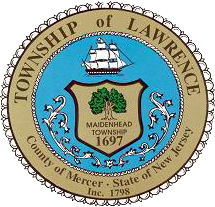 Lawrence was founded in 1697, and for most of its three centuries it was a typical rural, agricultural, New Jersey community that travelers passed through on their way from New Brunswick to Trenton or from Philadelphia to New York.
Lawrence was founded in 1697, and for most of its three centuries it was a typical rural, agricultural, New Jersey community that travelers passed through on their way from New Brunswick to Trenton or from Philadelphia to New York.
Since the township is equidistant between Philadelphia and New York, it should not be surprising that many of the major north-south transportation corridors of the Northeastern U.S. – both past and present – pass through Lawrence. These include:
- The King’s Highway (now US 206), dating to the 18th century, locally now part of the Federally-designated King's Highway Historic District.
- The Brunswick Pike (now US 1), chartered in 1804.
- The Delaware & Raritan Canal, dating to the 1830s, locally now part of the Federally-designated Delaware and Raritan Canal Historic District.
- The Camden & Amboy Railroad (now Amtrak’s Northeast Corridor), also dating to the 1830s, locally now part of the state-designated Camden and Amboy Railroad Branch Line Historic District.
- Interstate 95 in the late 20th century
As a state, New Jersey's history has tended to be defined by its location between two big urban neighbors – New York City to the north and Philadelphia to the south. In a similar manner, Lawrence Township's history has often been determined by its location between two more historically prominent neighbors, Princeton to the north and Trenton to the south.
Lawrence’s most famous Revolutionary War episode – the crucial delaying action of Colonel Edward Hand before the second battle of Trenton in January 1777 – took place as the British and Colonial armies were passing through - in this case from Princeton to Trenton. Colonel Hand’s achievement is still celebrated every year with a march to Trenton from the Township Municipal Building.
 Lawence Township’s original name was Maidenhead, a part of Burlington County on the border of what was then West Jersey. Initially named by early Quaker settlers after a Thames River village outside London, the name was changed in 1816 to Lawrence in honor of Capt. James Lawrence, the commander of the frigate Chesapeake and a naval hero of the war of 1812. As political boundaries evolved in colonial and post-colonial New Jersey, Lawrence became part of Hunterdon County in 1714, before finally becoming part of the then-new Mercer County in 1838.
Lawence Township’s original name was Maidenhead, a part of Burlington County on the border of what was then West Jersey. Initially named by early Quaker settlers after a Thames River village outside London, the name was changed in 1816 to Lawrence in honor of Capt. James Lawrence, the commander of the frigate Chesapeake and a naval hero of the war of 1812. As political boundaries evolved in colonial and post-colonial New Jersey, Lawrence became part of Hunterdon County in 1714, before finally becoming part of the then-new Mercer County in 1838.
The eastern boundary of Lawrence - separating the township from Princeton and West Windsor Townships - is defined by New Jersey's Province Line, laid out in 1696 by surveyor George Keith to divide West Jersey from East Jersey. Twenty municipalities in the state include the Province Line as part of their boundaries, and Lawrence's is among the longest.
 The original township was slightly larger than the current one. In the late 19th century a neighborhood at the south end of town seceded to become its own municipality – Millham Township. Millham’s independence was short-lived, however. A few years later it was annexed to Trenton. Today, the neighborhood of the former Millham is best known as the home of the Fuld Campus of Capital Health Systems, just below the Brunswick Circle.
The original township was slightly larger than the current one. In the late 19th century a neighborhood at the south end of town seceded to become its own municipality – Millham Township. Millham’s independence was short-lived, however. A few years later it was annexed to Trenton. Today, the neighborhood of the former Millham is best known as the home of the Fuld Campus of Capital Health Systems, just below the Brunswick Circle.
Lawrence first became a destination in its own right in the 19th century with the founding of Maidenhead Academy, forerunner to The Lawrenceville School – today one of the nation’s elite boarding schools. The Lawrenceville School was the chief economic and political engine behind the development of the Village of Lawrenceville (now the Lawrenceville Main Street Historic District) during the 19th and 20th centuries.
The township began its transformation from an agricultural to a suburban community in the early 20th century, when industrial workers from Trenton began moving into new neighborhoods along the southern border. From 1900 to 1930, Lawrence’s population more than quadrupled from 1,500 to over 6,000.
But it was not until after World War II that Lawrence began to take on its current suburban character. With the construction of large housing subdivisions in the central part of the township, from 1950 to 1970 the population more than doubled from 8,500 to over 19,000. As part of that suburban migration, Rider College (today Rider University) moved from Trenton to its current Lawrence campus in 1959.
In the final decades of the 20th century Lawrence added another 10,000 residents as the northern end of the township emerged as a suburb of Princeton and the Route 1 Corridor. The township’s two major corporate campuses – Educational Testing Service and Bristol-Myers Squibb – grew to their current dimensions, as did the Quakerbridge Mall, which became the catalyst for significant retail development along Route 1.
For more details on Lawrence geography, demographics, and other facts, visit Wikipedia.org.

